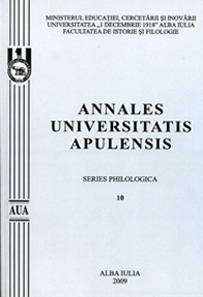LES MÉTAPHORES EN PIERRE DE BRÂNCUŞI ET L’ESTHÉTIQUE DU MODERNISME LITTÉRAIRE
BRÂNCUŞI’S METAPHORS IN STONE AND THE AESTHETICS OF LITERARY MODERNISM
Author(s): Mariana PerişanuSubject(s): Cultural history
Published by: Universitatea »1 Decembrie 1918« Alba Iulia
Keywords: interdisciplinarity; Brancusi; writer friends; aesthetics; modernism; stone metaphors
Summary/Abstract: The interdisciplinarity between literature and the art of sculpture was illustrated at the highest level by the collaboration of Brancusi with his writer friends: Guillaume Apollinaire, Raymond Radiguet, André Salmon, Blaise Cendrars, Paul Morand, Ezra Pound, James Joyce, Benjamin Fondane, Raymond Queneau, Eugène Ionesco, Tudor Arghezi, Lucian Blaga, Ion Minulescu, Dan Botta. According to Pound, Brancusi and his art have launched «a new aesthetic order». The American poet noticed Brancusi’s effort to “go into the depths of the infinite through shape” and he was among the first to understand the role played by his aesthetics in the configuration of modernism and even in the choice of the strategies employed by the literatures of the 20th century. The Endless Column and The Table of Silence at the same time draw close and make the difference between Ezra Pound and James Joyce for whom the sculptor created six sketches for the drawing-portrait of the Parisian edition of Finnegans’ Wake. Brancusi’s Impasse Ronsin studio was a temple of the art frequented religiously by a number of artists and writers. Tristan Tzara appreciates “the delicious meals” and “the very attractive sculptures”. Apollinaire situates his friend’s sculptures among “the most refined works” (Le Salon des Indépendants, 1912). Paul Morand draws a memorable portrait of him in the catalogue of the New York exhibition of 1926, reprinted in the Papiers d’identité (1931) and Salmon calls him in his Souvenirs sans fin (1961) “the Stéphane Mallarmé of statues”. The “rural prince” of Montparnasse was also greatly appreciated in the Bucharest cultural effervescence of the years 1920-1940. Lucian Blaga, Ion Vinea, Ion Barbu, Marin Sorescu later dedicated poems to him. Ion Minulescu considers him “an entity of Romanian genius”. Brancusi executes some illustrations for Ilarie Voronca’s volume Plants and animals and the novel Interview of the same Voronca is inspired by the sculptor’s initiative. Arghezi welcomes “the pieces of stone, marble or wood that Brancusi used to throw from time to time from his studio’s window to fascinate the world” (Seara, 23 June 1914), whereas the author of Jocul ielelor writes down in 1928 about “the obstinacy of Brancusi in his pursuit of ideas”. The meeting of the old sculptor is evoked with humor in Notes et contre-notes by Ionesco who estimates that Brancusi “had assimilated all the history of sculpture, had dominated it, surpassed it, rejected it, discovered it again, purified it, reinvented it. He had identified its essence. […] By stylizing it, Brancusi condenses matter, inscribing the forms in the geometry of natural structures, in the rhythm of life”. Brancusi is himself a great poet. He often explained his works with brilliant aphoristic statements, almost shocking, some of them mentioned while he was working. His aesthetic and ethic doctrine exposed in “small bites” reveals one of the most lucid and sensitive poets and philosophers.
Journal: Annales Universitatis Apulensis. Series Philologica
- Issue Year: 11/2010
- Issue No: 3
- Page Range: 205-217
- Page Count: 13
- Language: French

